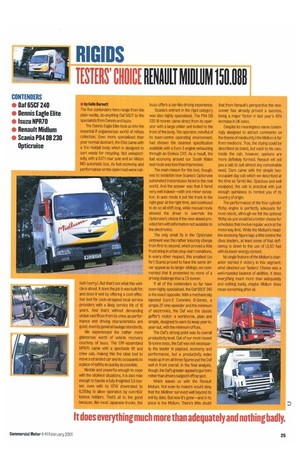RIGIDS
Page 27

If you've noticed an error in this article please click here to report it so we can fix it.
TESTERS'
CHOICE CHOICE RENAULT MIEN
le by Conn Barnett The five contenders here range from the plain-vanilla. do-anything Daf 65CF to the specialists from Dennis and Isuzu.
The Dennis Eagle Elite took us into the essential if unglamorous world of refuse collection. Even more specialised than your normal dustcart, the Elite came with a Trio Holdall body which is designed to sort waste for recycling. Not unexpectedly, with a 617:1 rear axle and an Allison MD automatic box, its fuel economy and performance on the open road were rub bish (sorry). But that's not what this vehicle is about. It does the job it was built for, and does it well by offering a cost-effective tool for cash-strapped local service providers with a likely service life of 10 years. And that's without demanding undue sacrifices from its crew, as performance and driving characteristics are good, even by general haulage standards.
We experienced the rather more glamorous world of vehicle recovery courtesy of Isuzu. The ERE-assembled NPR70 came with a spectacle lift and crew cab, making this the ideal tool to move a stranded car and its occupants to a place of safety as quickly as possible.
Nimble and powerful enough to cope with the stickiest situations, it is also man enough to handle a fully-freighted 3.5-tonnor, even with its GTW downrated to 8,250kg to allow operation by non-HGV licence holders. That's all to the good because, like most Japanese trucks, the
Isuzu offers a car-like driving experience.
Scania's entrant in the rigid category was also highly specialised. The P94 DB 230 18-tonner came direct from its operator with a large chiller unit bolted to the front of the body The operator, mindful of its town-centre operating environment, had chosen the cleanest specification available with a Euro-3 engine exhausting through an Eminox CRT. As a result, the fuel economy around our South Wales test route was less than impressive.
The main reason for this test, though, was to establish how Scania's Opticruise automated transmission fared in the real world. And the answer was that it fared very well indeed—with one minor exception. In auto mode it put the truck in the right gear at the right time, and continued to do so all shift long, while manual mode allowed the driver to override the Opticruise's choice if the view ahead provided him with information not available to the electronics.
The only small fly in the Opticruise ointment was the rather leisurely change from first to second, which proved a little frustrating in urban stop-start conditions. In every other respect, this smallest (so far) Scania proved to have the same driver appeal as its larger siblings; we commented that it presented no more of a driving challenge than a 7.5-tonner.
If all of the contenders so far have been highly specialised, the Daf 65CF 240 is the exact opposite. With a mechanically injected Euro-2 Cummins B-Series, a simple ZF nine-speeder and the minimum of electronics, the Daf was the classic gaffer's motor: a workhorse, plain and simple, designed to earn its keep year-in, year-out, with the minimum of fuss.
The Des strong point was its overall productivity level. Out of our most recent 18-tonne tests, the Daf was not necessarily the leader in payload, economy and performance, but a productivity index made up from all three figures put the Oaf well in front overall. In the final analysis, though, the Oaf's greater appeal to guv'nors rather than drivers nudged it off top spot.
Which leaves us with the Renault Midlum. Not even its makers would deny that the Midliner survived well beyond its sell-by date. But now it's gone—and in its place is the Midlum. There's little doubt that from Renault's perspective the newcomer has already proved a success, being a major factor in last year's 40% increase in UK sales.
Despite its meaningless name (seemingly designed to attract comments on the theme of mediocrity) the Midlum is far from mediocre. True, the styling could be described as bland, but each to his own. Inside the cab, however, opinions are more definitely formed. Renault will sell you a cab to suit almost any conceivable need. Ours came with the simple twooccupant day cab which we described at the time as Tardis-like. Spacious and well equipped, the cab is practical with just enough quirkiness to remind you of its country of origin.
The performance of the four-cylinder 150hp engine is perfectly adequate for most needs, although we felt the optional 180hp six-pot would be a better choice for schedules that involve regular work at the motorway limit. While the Midlum's headline economy figure lags a little behind the class leaders, at least some of that deficiency is down to the use of ULSD fuel with its lower energy content.
No single feature of the Midlum's character earned it victory in this segment: what clinched our Testers' Choice was a well-rounded balance of abilities. it does everything much more than adequately and nothing badly...maybe Midlum does mean something after all.
































































































